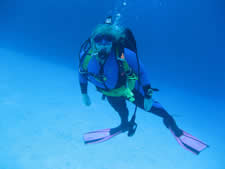 |
|
Cindy LaRosa on the first dive on the first day, Monday, Dec. 12, over the sand on Columbia Reef. This reef has lots of caverns, swim-throughs, and a pretty reef. (Photo by Kevin Magee) |
 |
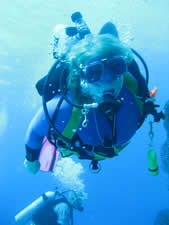 |
|
Cindy LaRosa swims along the reef with another diver behind her. Columbia Reef has many ravines and sand chutes to navigate through among the tall pillars of coral. (Photo by Kevin Magee) |
 |
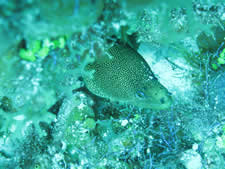 |
|
A goldentail moray eel peers out of its hole on the second dive in the Columbia Shallows. Despite movies and books depicting moray eels as dangerous, they are in fact shy reclusive animals that divers always enjoy seeing. (Photo by Cindy LaRosa) |
 |
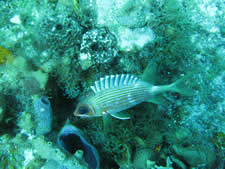 |
|
A longspine squirrelfish rests in the shadows of the reef in the Columbia Shallows. Its large eyes are for hunting at night, which is when this fish is most active. (Photo by Cindy LaRosa) |
 |
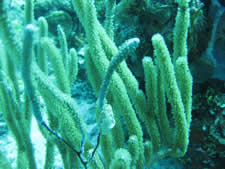 |
|
A Flamingo Tongue feasts on gorgonian soft coral. This strangely named critter is a common and colorful snail with a fleshy mantle extended over its shell. (Photo by Cindy LaRosa) |
 |
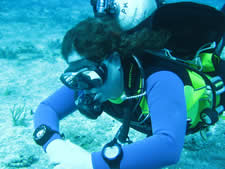 |
|
Kevin Magee drifts along the Columbia Shallows. Most diving in Cozumel is drift diving, where the divers float along in the south-to-north current and are picked up by the boat at the end of the dive. It is effortless and very relaxing diving. (Photo by Cindy LaRosa) |
 |
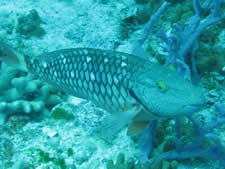 |
|
A stoplight parrotfish in its initial color phase. The funny mouth is a hard beak for eating coral, and they can regularly be observed crashing head-first into the bottom with an audible crunch. They are also largely responsible for the fine white beach sand that tropical sunbathers treasure when the coral's remnants are excreted. (Photo by Cindy LaRosa) |
 |
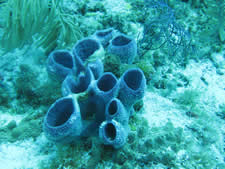 |
|
A brilliant blue branching vase sponge in Columbia Shallows. It is a tube-shaped cluster that is actually an animal. Sponges are the simplest form of multicellular animal life and are the distant ancestors to all animal life on the planet. (Photo by Cindy LaRosa) |
 |
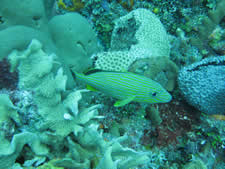 |
|
A bluestriped grunt rests among coral and sponges. Thin leaf lettuce coral is to the left, and black-ball sponge is to the right. (Photo by Cindy LaRosa) |
 |
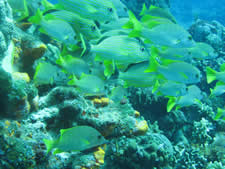 |
|
A school of grunts hovers over the top of the reef at Columbia Shallows. Bluestriped grunts are towards the top, and schoolmasters are to the right with the yellow tails. (Photo by Cindy LaRosa) |
 |
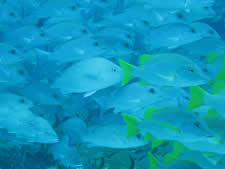 |
|
A tightly packed school of three types of grunts. Sailors choice are towards the top, a margate is in the middle, and schoolmasters are towards the right. (Photo by Cindy LaRosa) |
 |
 |
|
A large school of four types of grunts: sailors choice at the top, margates in the middle, schoolmasters to the right, and bluestriped grunts at the bottom. Large schools of grunts are commonly found at Columbia Shallows. (Photo by Cindy LaRosa) |
 |
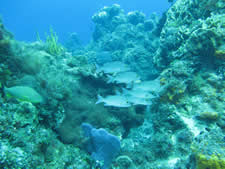 |
|
A small school of mahogany snapper huddle on top of Columbia Shallows. The top of the reef is only 15-20 feet (4-6 meters) deep, allowing a long safety stop while admiring the scenery. (Photo by Cindy LaRosa) |
 |
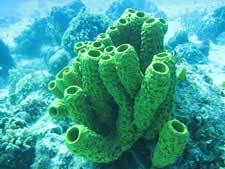 |
|
Yellow tube sponges on top of the reef. These sponges are very striking and appear almost to be a fluorescent lime green. (Photo by Cindy LaRosa) |
 |
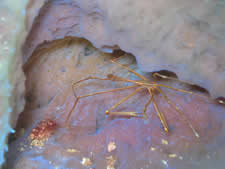 |
|
A yellowline arrow crab rests on a sponge. This strange alien-looking crab is very common in Cozumel, and its tiny claws have bright blue tips. (Photo by Cindy LaRosa) |
 |
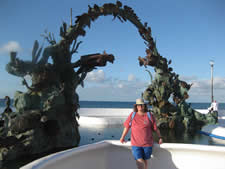 |
|
After diving Monday morning, Kevin and Cindy walked to the main town, San Miguel, in the afternoon. They discovered this diver's monument, and Kevin couldn't resist getting his picture taken in front of it. (Photo by Cindy LaRosa) |
 |
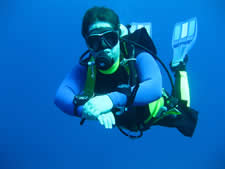 |
|
Kevin Magee drifting on the first dive of Tuesday, Dec. 13. This was on El Cedral Reef, a deep rolling reef with a very strong current and lots of fish life. (Photo by Cindy LaRosa) |
 |
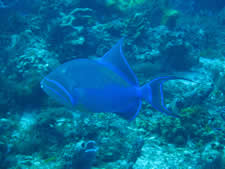 |
|
A queen triggerfish, which is quite striking in its markings. They are fairly common in Cozumel and not too scared of divers, allowing a good view of them. (Photo by Cindy LaRosa) |
 |
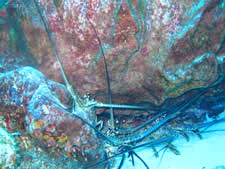 |
|
A group of spiny lobsters hiding under a sponge. The main dive sites along the west coast of Cozumel are protected from hunting, allowing these coveted seafood items to be fairly common. (Photo by Cindy LaRosa) |
 |
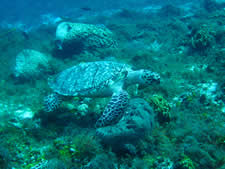 |
|
A hawksbill sea turtle cruises the bottom on El Cedral Reef looking for tasty sponges to eat. (Photo by Cindy LaRosa) |
 |
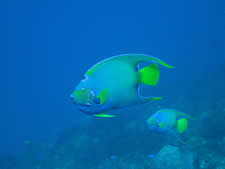 |
|
Two queen angelfish cruise along the El Cedral Reef wall. Although normally shy and wary of divers in many parts of the Caribbean, they were surprisingly approachable in Cozumel. (Photo by Cindy LaRosa) |
 |
